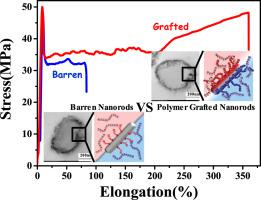Composites Part B: Engineering ( IF 12.7 ) Pub Date : 2020-06-10 , DOI: 10.1016/j.compositesb.2020.108153 Xuan Li , Zhiang Fu , Xiaoying Gu , Huanhuan Liu , Hengti Wang , Yongjin Li

|
Polymer blend nanocomposites with the nanoparticles exclusively located at the interface have attracted significant attention while the compatibilization functions of such nanoparticles in the blends are still controversial. Herein, the pristine boehmite nanorods (p-BNRs) and epoxide group modified boehmite nanorods (m-BNRs) have been synthesized and incorporated in the immiscible Poly(l-lactide)/Poly(1,4-butylene succinate) (PLLA/PBSU) blends. It is found that both p-BNRs and m-BNRs are thermodynamically located at the interface and the phase morphologies of the two nanocomposites are very similar at the same nanofiller loadings. However, the two nanocomposites exhibit different mechanical properties. The PLLA/PBSU blend nanocomposites with m-BNRs show increased elongation at break, enhanced notched impact strength and improved yield strength, as compared with the binary PLLA/PBSU blends. In contrast, p-BNRs lead to drastically deteriorating mechanical properties of the PLLA/PBSU blends even with all p-BNRs located at the interface. The investigation indicates that p-BNRs at the interface have barren surface and are lack of specific interactions with the polymers in the neighboring phases. In contrast, the epoxide groups on m-BNRs reacted with the end carboxylic acid groups of both PLLA and PBSU and the polymer chains were chemically bonded onto the surface of nanorods. The chemically bonded polymer chains on the nanorods at the interface can entangle with the molecular chains of the two polymers to enhance the interfacial adhesion. This paper demonstrates the significance of molecular chain entanglements of the compatibilizing nanoparticles and paves a new possibility to fabricate new materials with simultaneously enhanced strength and toughness.
中文翻译:

界面定位的纳米棒:贫瘠的纳米棒与聚合物接枝的纳米棒
具有仅位于界面处的纳米颗粒的聚合物共混物纳米复合材料引起了极大的关注,而这种纳米颗粒在共混物中的相容性功能仍存在争议。本文中,已合成了原始的勃姆石纳米棒(p-BNRs)和环氧基改性的勃姆石纳米棒(m-BNRs),并将其掺入不混溶的Poly(l)-丙交酯)/聚(1,4-丁烯琥珀酸酯)(PLLA / PBSU)混合物。发现p-BNRs和m-BNRs都在热力学上位于界面处,并且在相同的纳米填料负载下,两种纳米复合材料的相态非常相似。然而,两种纳米复合材料表现出不同的机械性能。与二元PLLA / PBSU共混物相比,具有m-BNR的PLLA / PBSU共混纳米复合材料显示出增加的断裂伸长率,增强的缺口冲击强度和改善的屈服强度。相反,即使所有p-BNR位于界面,p-BNR也会导致PLLA / PBSU共混物的机械性能急剧下降。研究表明,界面处的p-BNR具有贫瘠的表面,并且与相邻相中的聚合物缺乏特异性相互作用。相反,m-BNRs上的环氧基与PLLA和PBSU的末端羧酸基反应,并且聚合物链化学键合到纳米棒的表面。在界面上的纳米棒上化学键合的聚合物链可以与两种聚合物的分子链缠结,以增强界面粘合力。本文证明了相容性纳米粒子分子链缠结的重要性,并为制造同时增强强度和韧性的新材料提供了新的可能性。在界面上的纳米棒上化学键合的聚合物链可以与两种聚合物的分子链缠结,以增强界面粘合力。本文证明了相容性纳米粒子分子链缠结的重要性,并为制造同时增强强度和韧性的新材料提供了新的可能性。在界面上的纳米棒上化学键合的聚合物链可以与两种聚合物的分子链缠结,以增强界面粘合力。本文证明了相容性纳米粒子分子链缠结的重要性,并为制造同时增强强度和韧性的新材料提供了新的可能性。











































 京公网安备 11010802027423号
京公网安备 11010802027423号